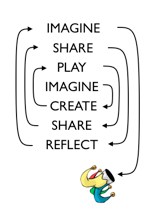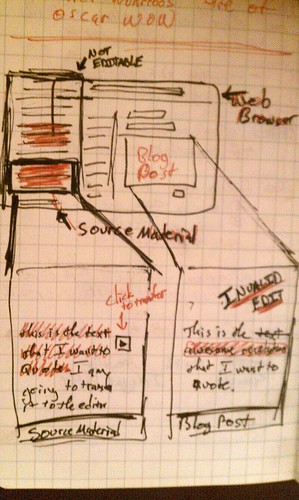How can designers imagine innovative technologies for news and journalism? I think I know the answer. In this post, I propose a model and demonstrate it by picking apart the “Profile article” for innovative ideas. The resulting design is a browser plugin which can attach writers’ tools to any text form on the web.
I’m currently taking Ethan Zuckerman’s class on News in the Age of Participatory Media, a compressed intro to journalism for engineers. In principle, we’re a group of engineers trying to learn enough about journalism to imagine new technologies to support journalism and media-making in general. In practice, that’s a really hard thing to do. People could genuinely argue that we’re only half-learning journalism in a fraction of the time students take in journalism school. Furthermore, we also need to think about technology. How can we do that?
- Learn about a particular issue in journalism
- Commit an act of journalism
- Reflect on that act as a designer
- Imagine what you might do to make it better
- Prototype something
- Play with it
- Share it with an audience
- GOTO 2
Learning about the broader issues in journalism is incredibly important. It’s poor planning to try to hack on an issue like fact-checking without some genuine understanding of what people think facts are, why they matter, and what’s already in the space. I agree with Ethan that actually committing acts of journalism is tremendously helpful. By asking us to write articles, Ethan is asking us to do what amounts to full-contact bodystorming. But we can’t assume that committing acts of journalism will automatically grant us epiphanies. We need to reflect on that act as designers, within the action as well as after the we complete the act. That gives a great starting point to imagine ways to improve things, at which point I think we can bring in Mitch and Hiroshi’s model to hack, prototype, and develop our ideas further.
Enough Talk. Let’s Do This.
For my next trick, I’m going to put this model into practice. This week, Ethan asked us to write a profile piece about one of our classmates. The class did some really wonderful pieces, which you can see at partnews.mit.edu. I didn’t finish mine. I did learn a lot (transcript of the interview, colour-coded) (my partly-written article).
I set out to write a profile of Eric French, co-editor of the leftist Costa Rican online opinion magazine Revista Amauta. As we talked on Skype, I recorded the interview with Audio Hijack Pro and transcribed it. This was easy for me, since I have pretty good typing skills and know how to slow down audio playback. Transcription was a major pain point for a lot of people, but it’s easy to learn and there are already several microwork audio transcription services, so I reckon that to be a solved problem. Background research was also a challenge, but services like PiPL can get the interviewer a long way.
We all agreed that it would be nice to have a tool for picking through someone’s Twitter and RSS history. I think the answer to that is to find and talk personally to a very specific kind of Twitter user: someone who (a) posts regularly, who (b) follows a smaller number of people, and (c) who has followed your person of interest for a long time. But it wasn’t my problem, so I’ll leave that as an exercise for the reader.
Challenge One: Background Research: In my interview, I focused on Eric’s difficult position of trying to amplify indigenous Costa Rican voices while living thousands of miles away in Rhode Island. There was no way I could get enough background on the Costa Rican media within a couple hours. I wanted to ask good questions and take the interview in interesting places, and the only way to do that was to pretend I knew what I was talking about. So before the interview, I spent two hours reading about Costa Rican media, reading Eric’s articles, and thinking about his situation. In the age of participatory media, we need to lessen the friction for ordinary bloggers to do great background research.
Challenge Two: Mining Source Material: My second problem happend as I wrote my article; I kept on forgetting which parts of the interview I had already quoted. Solving that one was easy for me. The low-fi option was to change the text colour when I cited it. The high fidelity option involved using a professional writing tool such as Tinderbox to tag sections of the interview which I had already used.
- Get someone else to help me do the interview. I don’t think I could outsource the interview entirely, since the interview subject will expect to talk to the writer, and since someone needs to think of the audience. Instead, I might talk to an expert in advance, inviting that expert to listen in on the conversation and text questions to my mobile. I’m sure some journalists do this, but how could we make this work for bloggers? Maybe in some cases, the expert genuinely wants to access to the featured person. Or maybe we combine spot.us with conference blogging and have someone from the readership doing the interview, with the blogger just writing the piece.
- Design a simple two-paned transcript mashup editor, a “firebug” for blog posts: It should mark material that I copy over, automatically add elipses where I need them, be sensible about grammatical fixes, and complain if I do violence to my source’s words. It should probably be a browser plugin, so I can combine it with any web-based text entry system. Subsequent versions could remind me of things which make a successful blog post: do I have a photo? Are my paragraphs too long? Have I referred to the Kardashians at least twice?
- Link to source material from profile pieces. Of course it’s messy and impressionistic. Of course hiding the transcripts shields you from a lot of risk. But if more journalists are transparent online about their work practices, they are more likely to gain the positive advantages of reflective practice, and members of the public can become more familiar with the journalistic norms. In principle, a transcript mashup editor would make it easy to publish this material.
Prototype
Let’s look at the transcript editor. I don’t have time to make it tonight, since it’s 11pm and I still need to edit the music video from my recent cover of Rebecca Black’s “Friday.” So here’s a drawing.
- Liveblogging macros
- Saving backups of material in browser text boxes
- Word count
- Flesch-Kinkaid readability checker
- Collaboratively edit any form with friends I choose
- Automatically insert HTML links back to a server which holds transcripts
Continuing the Journalism Innovation Spiral



